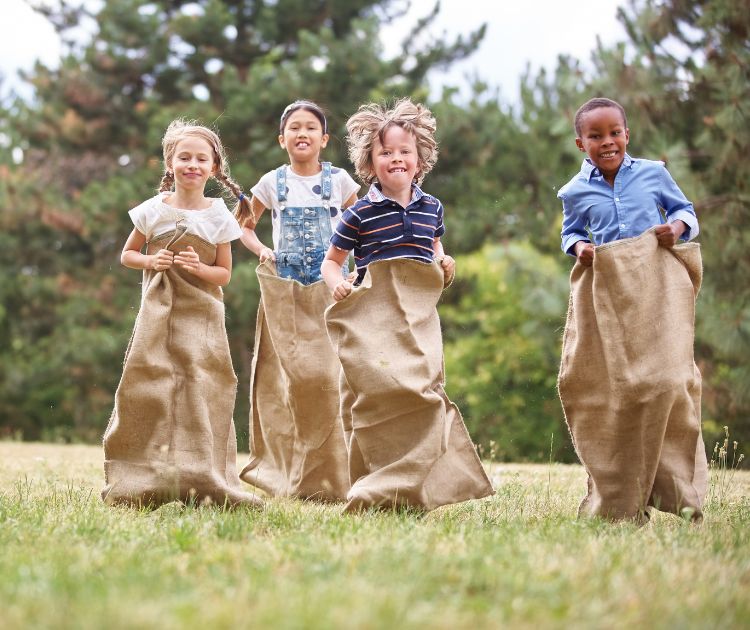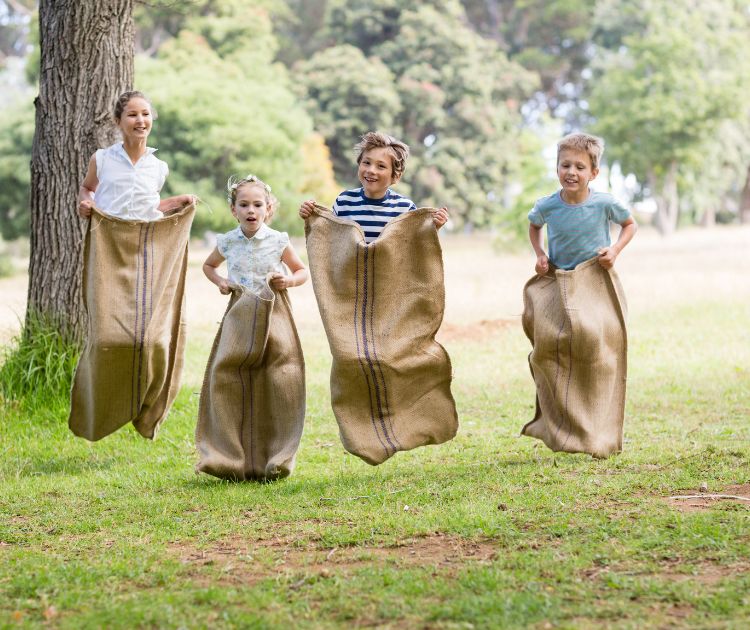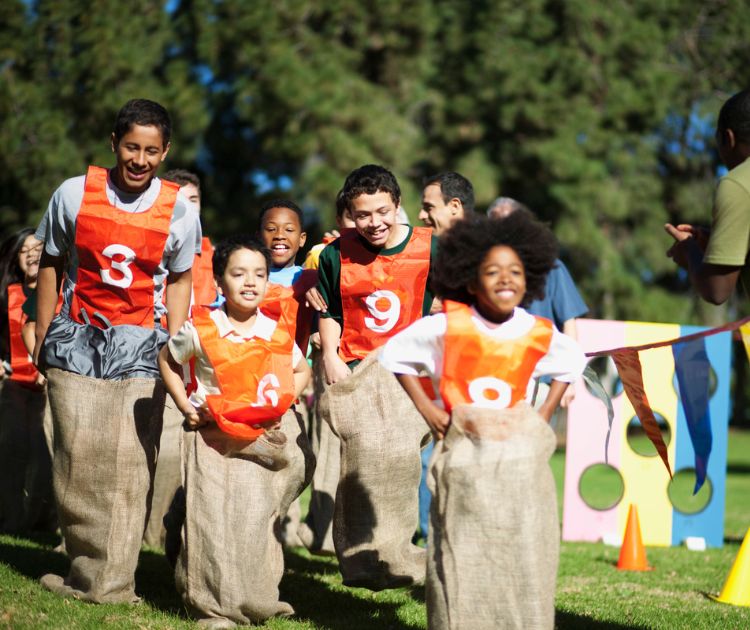Sack race: the birthday and party game for children and adults

Sack race: the outdoor activity that pleases the whole family
Looking for a fun activity to liven up a birthday party or outdoor event? Sack racing is a traditional game that never fails to excite both children and adults. This activity, suitable from age 5, combines fun and physical exercise without requiring expensive equipment. Discover how to organize this must-have activity that guarantees laughter while developing coordination and strengthening team spirit.
Sack racing: an essential fun activity
Sack racing is a fun outdoor game where participants place their legs in sacks, usually made of burlap, to progress by jumping to the finish line. This entertainment combines physical effort and moments of laughter, making it perfect for children's birthday parties and outdoor family gatherings.
The origins of this activity date back to the 19th century. At that time, sack racing was seriously practiced in the United States before transforming into a recreational activity popular at fairs and festivals. The Lumière Brothers even immortalized it in one of their first films in 1896.
This traditional game draws its charm from its simplicity and accessibility. No need for expensive equipment or complex installations to organize a successful sack race. All you need are some sturdy sacks and a clear space to create a festive atmosphere that will delight participants and spectators.
Given its comedic aspect and low technical requirements, sack racing is suitable for all generations. Children from age 5 can participate enthusiastically, while adults rediscover the simple pleasure of playing together. The world record for the 100-meter sack race is held by Stephen Wildish with an impressive time of 26.22 seconds.

The necessary equipment to organize a sack race
For a successful sack race, the choice of sacks is important. Choose traditional burlap sacks, resistant and stable, or alternatives in thick fabric. Check that they are adapted to children's size to avoid falls and frustrations.
The play area must be carefully prepared with flat terrain clear of obstacles. Clearly mark the start and finish lines with visible markers such as colored cones or chalk, ensuring sufficient space between participants.
- Choose appropriate sacks: Opt for sturdy burlap sacks or heavy fabric alternatives, ensuring they are sized appropriately for children to prevent falls. The durability of the sacks is crucial for ensuring safety and smooth race operation.
- Prepare a safe terrain: Select a flat playing area clear of any obstacles, such as stones or branches, to minimize injury risks during the race. A well-prepared terrain ensures a smooth activity.
- Mark start and finish lines: Use colored cones, chalk, or ribbons to clearly mark the start and finish lines, allowing sufficient space between participants to avoid collisions. Clear boundaries allow players to properly visualize the course.
- Provide safety equipment (if necessary): For races organized in the evening or on potentially dangerous grounds, remember to include reflective vests, night lights, or even knee pads for younger participants. Children's safety should always be a priority.
By following these recommendations, you will be able to set up a fun and safe sack race for all participants.
Basic rules of sack racing

The fundamental rules of sack racing are simple but important to ensure fair competition. Each participant must place their legs in the sack and hold it at waist height with their hands. This position allows good balance while limiting the risk of falling. Movement is only by successive jumps, never walking or running.
The competition starts when all players are positioned on the starting line. At the signal, participants race toward the finish line by hopping in their sack. The first to completely cross this line is declared the winner of the race. Remember to clearly mark these two lines to avoid any disputes.
If a player falls during the race or accidentally exits their sack, they must resume their initial position before continuing. Some variants require starting over from the starting line, while others allow resuming where the incident occurred. It is generally forbidden to release the sack with one or both hands during the entire event.
Create a suitable and entertaining sack race course
The course length must be adapted to the participants' age to ensure a pleasant experience for everyone.
Plan for about 10-15 meters for children aged 5-7, allowing them to participate without getting too tired quickly.
For older children and adults, a distance of 30-40 meters offers a more challenging experience while maintaining the fun of the game.
A slightly uneven terrain adds an extra dimension to the sack race without compromising safety. These small variations in relief require more coordination from participants and make the activity more stimulating. However, ensure that the ground remains stable enough to prevent dangerous falls during jumps.
To enhance your standard sack race, consider incorporating additional fun elements. Slaloms between colored cones require participants to control their direction while maintaining balance in the sack. These intermediate challenges transform a simple straight line into a strategic course.
Object collection zones are another way to enhance the course. Place balls or small toys that children must collect without leaving their sack. This additional task develops their hand-eye coordination while adding a tactical dimension to the classic race.

Fun variants to renew the activity
The relay sack race transforms the game into a collective challenge where each team must coordinate passing the sack between teammates. This variant strengthens group cohesion and maintains participants' enthusiasm throughout the activity.
The two-person race, where two children share a large bag, adds a cooperative dimension to the game. Participants must synchronize their movements to move forward effectively, promoting communication and teamwork in an atmosphere of celebration and shared laughter.
- Organize a relay race: Divide participants into teams and have them pass the sack in turn after covering a defined distance. This variant promotes team spirit and coordination.
- Set up an obstacle course: Add cones to go around, hoops to jump through, or tunnels to cross to increase difficulty and stimulate players' agility. Adapt obstacles to children's age and abilities.
- Offer paired racing: Have two children run together in the same sack, forcing them to synchronize their movements and cooperate to move forward. This option is ideal for strengthening bonds and encouraging mutual help.
- Create a themed race: Ask participants to come in costume or perform specific actions during the race, such as collecting objects or solving riddles. Let your imagination run wild for an unforgettable party.
To vary the fun at your events, also consider other traditional games like hide-and-seek, which also offers numerous possibilities.
Ensuring children and adult safety
Active supervision of children is an important element throughout a sack race. An adult must be present to supervise the game, intervene quickly in case of falls, and ensure all participants follow safety guidelines. Choosing flat, clear terrain significantly reduces the risk of accidents.
For sack racing, protective equipment is generally not essential. However, make sure children wear appropriate shoes and comfortable clothing that facilitate their movements. On rougher terrain like dry lawns or graveled surfaces, knee pads may be useful, particularly for younger children.
How to organize a sack race event?
Incorporating sack racing into a children's birthday party creates a highlight of the celebration. Plan this activity for early afternoon when energy levels are at their peak, and provide symbolic prizes for all participants, valuing effort rather than victory. Children particularly enjoy this activity that combines competitive spirit with shared laughter.
For a more ambitious event like a fair or neighborhood festival, structure several qualifying rounds followed by a final. This organization allows for greater participant involvement and creates a truly festive atmosphere around the sack race. You can also plan different age categories so everyone finds their place in the competition.
A point system can be implemented if you integrate sack racing into family Olympics. Each team accumulates points through different events, maintaining interest throughout the event. Consider designating a referee who will ensure rules are followed and time the races for greater fairness between players.
The award ceremony constitutes a special moment that ideally closes the activity. Even for a simple birthday party, plan small prizes like candy or toys for all children, with perhaps a medal or trophy for the winner. The essential is to celebrate everyone's participation and efforts in a joyful atmosphere.
Educational and physical benefits \n
Sack racing remarkably develops children's gross motor skills. The precarious balance in the sack strengthens leg muscles, improves coordination, and refines balance sense. This playful activity works the entire body through unusual movements that contribute to the harmonious physical development of young participants.
Beyond physical aspects, this activity also teaches significant social skills. Children learn to respect rules, accept defeat with fair play, and encourage their peers. These values are naturally transmitted through this collective game that values both individual effort and sportsmanship in a joyful atmosphere.
Perseverance is another major asset cultivated during sack racing. Faced with movement difficulties, children must persist despite falls. This is why this activity helps strengthen their determination and ability to overcome obstacles, essential qualities that will serve them well beyond the playground.
Since this activity is often practiced outdoors, it offers children valuable contact with nature. Outdoor games promote better oxygenation and stimulate the brain differently. Thus, sack racing cleverly combines social learning and health benefits in an activity accessible to all.
Educational and physical benefits \n

For toddlers aged 3-5, simplify the activity with wider and easier-to-handle sacks. Plan a very short course, not exceeding 10 meters, and remain available to help children who might have difficulties. At this age, the goal is more about participation than competition.
Teenagers and adults prefer more substantial challenges. You can offer longer courses reaching 30 to 40 meters with various obstacles such as slaloms or balance zones. Team races add a strategic dimension particularly appreciated by this audience.
For children between 6 and 10 years old, the classic sack race with a 15 to 20-meter course perfectly matches their abilities. You can add some simple obstacles to maintain their interest throughout the activity. Rules should remain clear and easy to understand.
Also remember to adapt the weight and size of sacks according to participants. Young children will use lightweight canvas sacks while adults will need more resistant ones to support their energetic movements during the race.
Which variant to choose?
To choose the ideal sack race variant, consider the age and available space. Classic races suit all ages, relays are good for children 7 and up, while obstacle courses are perfect for more athletic participants. Cooperative variants reassure more timid players.
Each mode attracts a specific audience: families prefer simple versions, schools and leisure centers opt for relays, and festive events often offer several formats. Regarding equipment, expect to pay 5-15€ for traditional jute sacks, 20-40€ for a complete kit with finish line.
Race type | Recommended age | Difficulty | Required equipment | Required space | Indicative price |
Classic race | 5+ years | Easy | Burlap or canvas sacks | 10-30m linear | 5-15€ |
Relay race | 7+ years | Medium | Sacks + baton | 20-40m linear | 15-25€ |
Obstacle race | 8+ years | Difficult | Sacks + obstacles | 30m² minimum | 30-50€ |
Paired race | 6+ years | Medium | Large sacks | 10-20 linear meters | 10-20€ |
Timed race | 9+ years | Medium | Sacks + stopwatch | 15-30m linear | 20-30€ |
Blindfolded race | 10+ years | Difficult | Sacks + blindfolds | 15m safe zone | 15-25€ |
Themed race | All ages | Variable | Decorated sacks | Variable | 20-40€ |
Team race | 7+ years | Medium | Colored team sacks | 30-50m² | 25-45€ |
Adult race | 16+ years | Difficult | Reinforced sacks | 30-50 linear meters | 15-30€ |
Complete activity kit | All ages | Variable | All-in-one kit | 50m² minimum | 40-80€ |
Sack racing remains a timeless fun activity that appeals to both young and old. Its simple organization, accessible equipment, and multiple variants make it an ideal game for animating birthday parties and family events. Beyond shared pleasure, this activity develops motor skills and team spirit in children while creating memorable experiences. Remember to adapt the course according to participants' age to ensure a successful experience. Don't wait to get your burlap sacks out for your next race – laughter is guaranteed!













 Choosing the right baby blanket dimensions according to season and age
Choosing the right baby blanket dimensions according to season and age
 How to attach a headboard (with or without drilling): quick and effective soluti
How to attach a headboard (with or without drilling): quick and effective soluti
 Waterproof sheet or mattress protector: the best solution by age group
Waterproof sheet or mattress protector: the best solution by age group
 27 Original, Useful, and Trendy Christmas Ideas for Teens 2025
27 Original, Useful, and Trendy Christmas Ideas for Teens 2025
 Christmas Activities for Baby: Creative Ideas for Home & Daycare
Christmas Activities for Baby: Creative Ideas for Home & Daycare